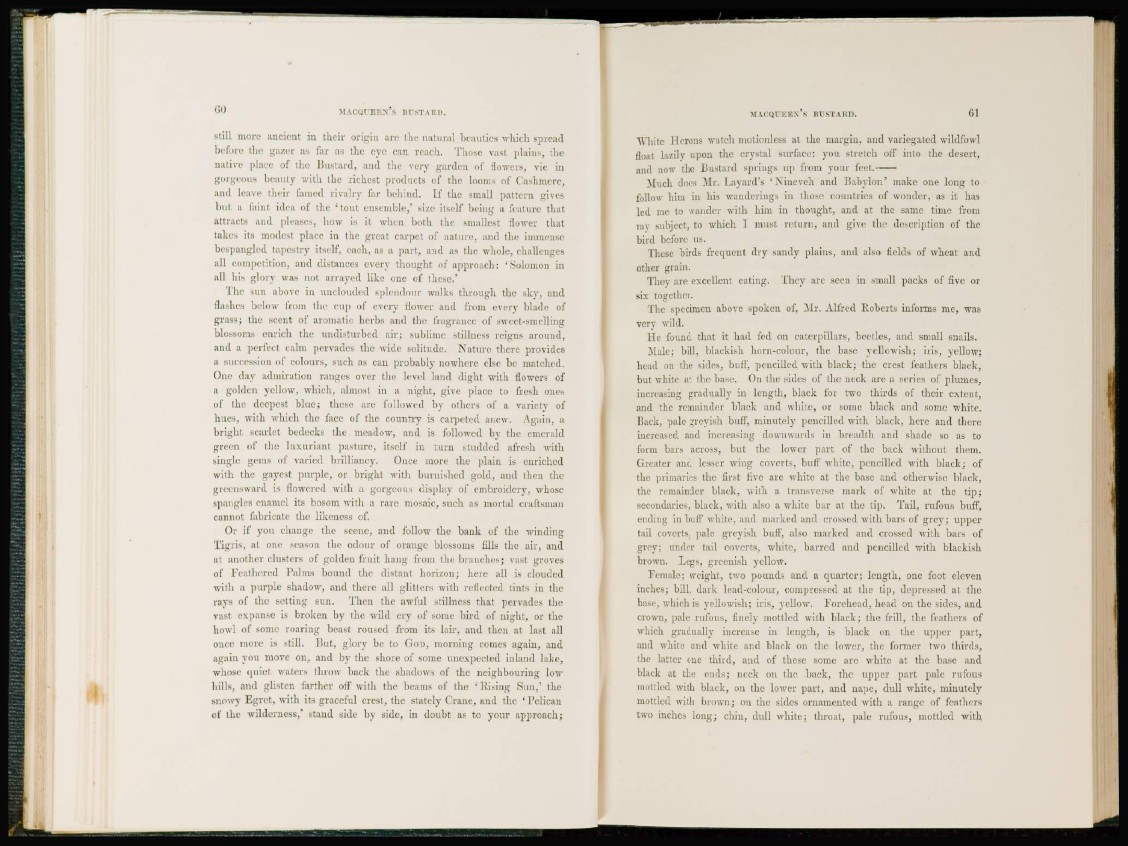
«¡0 MACQTJEEN'S BUSTARD.
slill more ancient in their origin are the natural beauties which spread
before the gazer as far as the eye can reach. Those vast plains, the
native; place of the Bustard, and the very garden of flowers, vie in
gorgeous beauty with the richest products of the looms of Cashmere,
and leave their famed rivalry far behind. If the small pattern gives
but a faint idea of the ' t o u t ensemble/ size itself being a feature that
attracts and pleases, how is it. when both the smallest flower that
takes its modest place in the great carpet of nature, and the immense
bespangled tapestry itself, each, as a part, and as the whole, challenges
all competition, and distances every thought of approach: 'Solomon in
all his glory was not arrayed like one of these.'
The sun above in unclouded splendour walks through the sky, and
(lashes below from the cup of every flower and from every blade of
grass; the scent of aromatic herbs and the fragrance of sweet-smelling
blossoms enrich the undisturbed air; sublime stillness reigns around,
and a perfect calm pervades the wide solitude. Nature there provides
a succession of colours, such as can probably nowhere else be matched.
One day admiration ranges over the level laud dight with flowers of
a golden yellow, which, almost in a night, give place to fresh ones
of the deepest blue; these are followed by others of a variety of
hues, with which the face of the country is carpeted anew. Again, a
bright scarlet bedecks the meadow, and is followed by the emerald
green of the luxuriant pasture, itself in turn studded afresh with
single gems of varied brilliancy. Once more the plain is enriched
with the gayest purple, or bright with burnished gold, and then the
greensward is flowered with a gorgeous display of embroidery, whose
spangles enamel its bosom with a rare mosaic, such as mortal craftsman
cannot fabricate the likeness of.
Or if 3rou change the scene, and follow the bank of the winding
Tigris, at one season the odour of orange blossoms fills the air, and
at another clusters of golden fruit hang from the branches; vast groves
of Feathered Palms bound the distant horizon; here all is clouded
with a purple shadow, and there all glitters with reflected tints in the
ravs of the setting sun. Then the awful stillness that pervades the
vast expanse is broken by the wild cry of some bird of night, or the
how 1 of some roaring beast roused from its lair, and then at last all
once more is still. But, glory be to Goo. morning comes again, and
again you move on, and by the shore of some unexpected inland lake,
whose quiet waters throw back the shadows of the neighbouring low
hills, and glisten farther off with the beams of the ' R i s i n g Sun,' the
snowy Egret, with its graceful crest, the stately Crane, and the 'Pelican
of the wilderness,' stand side by side, in doubt as to your approach;
M A C Q U E E X S B U S T A R D. (¡1
White Herons watch motionless at the margin, and variegated wildfowd
float lazily upon the crystal surface: you stretch off into the desert,
and now the Bustard springs up from your feet.
Much does Mr. Layard's 'Nineveh and Babylon' make one long to
follow him in his wanderings in those countries of wonder, as it has
led me to wander with him in thought, and at the same time from
my subject, to which I must return, and give the description of the
bird before us.
These birds frequent dry sandy plains, and also fields of wheat and
other grain.
They are excellent eating. They are seen in small packs of five or
six together.
The specimen above spoken of, Mr. Alfred Roberts informs me, was
very wild.
He found that it had fed on caterpillars, beetles, and small snails.
Male; bill, blackish horn-colour, the base yellowish; iris, yellow;
head on the sides, buff, pencilled with black; the crest feathers black,
but white at the base. On the sides of the neck are a series of plumes,
increasing gradually in length, black for two thirds of their extent,
and the remainder black and white, or some black and some white.
Hack, pale greyish buff, minutely pencilled with black, here and there
increased and increasing downwards in breadth and shade so as to
form bars across, but the lower part of the back without them.
Greater and lesser wing coverts, buff white, pencilled with black; of
the primaries the first five are white at the base and otherwise black,
the remainder black, with a t ransverse mark of white at the tip;
secondaries, black, with also a white bar at the tip. Tail, rufous buff,
ending in buff white, and marked and crossed with bars of grey; upper
tail coverts, pale greyish buff, also marked and crossed with bars of
grey; under tail coverts, white, barred and pencilled with blackish
brown. Legs, greenish yellow.
Female; weight, two pounds and a q u a r t e r ; length, one foot eleven
inches; bill, dark lead-colour, compressed at the tip, depressed at the
base, which is yellowish; iris, yellow. Forehead, head on the sides, and
crown, pale rufous, finely mottled with black; the frill, the feathers of
which gradually increase in length, is black on the upper part,
and white and white and black on the lower, the former two thirds,
the latter one third, and of these some are white at the base and
black at the ends; neck on the back, the upper part pale rufous
mottled with black, on the lower part, and nape, dull white, minutely
mottled with brown; on the sides ornamented with a range of feathers
two inches long; chin, dull white; throat, pale rufous, mottled with